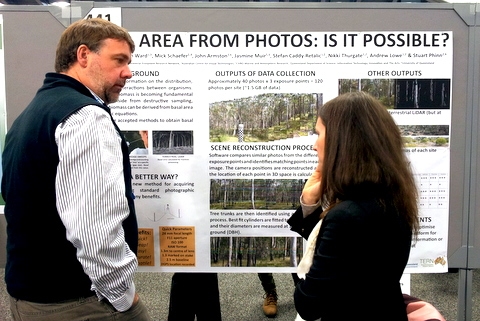Ben Sparrow discusses the AusPlots photopoint method with Leah Wasser from NEON.
2013 has seen TERN’s collaborative networks of infrastructure and people continue to mature, and grow beyond the borders of Australia’s shores. With increasing international attention focussed on TERN’s successes in delivering game-changing research infrastructure in a short space of time, the annual Fall Meeting of the American Geophysical Union (AGU) was the perfect opportunity for TERN to present itself on a global stage, strengthening existing relationships and building new connections.
The AGU Fall Meeting is the largest worldwide conference in geophysical sciences, covering a wide swathe of disciplines under the broad ‘ecosystem science’ banner. This year, the 22,000 attendees included a small but spirited TERN delegation, proud to represent not only TERN but the Australian ecosystem science community.
TERN hit the ground running on the first day of the meeting, co-convening a special session with our partners the National Ecological Observatory Network (NEON Inc.). The joint session, ‘Scaling ecosystem observations through space and time’, is a key topic for both groups, and a critical international science question – linking field observations to airborne or satellite image data or other spatial data, to derive output maps or time series maps of specific ecological and biophysical variables.
Over 27 abstracts were submitted for the session from across the globe, providing a wealth of content. There were many lively conversations throughout the posters, including steady attention to a poster describing the innovative photopoints method developed by TERN’s AusPlots facility to determine basal area.
Ben Sparrow, AusPlots Director and lead author on the poster said, ‘It was great to have an opportunity to present our work to an international audience, and to see so many people interested in the work we’re doing.’
The AusPlots photopoints method drew a diverse audience from researchers and tech companies, through to other research infrastructure providers like our partners at NEON. The possible adoption of the AusPlots photopoints method at NEON sites is just one element of our continuing cross-continental collaborations (read more below).
Off to a great start, the speaking session later in the day also proved to be a great success with standing room only to hear presenters including Dr Brad Evans – Director of TERN’s Ecosystem Modelling and Scaling Infrastructure talking about modelling, scaling, benchmarking and data assimilation for the Australian continent; alongside Prof Alfredo Huete presenting on the scaling of flux and satellite data from TERN’s OzFlux and AusCover facilities to compare ecosystem function across biomes, seasons, and extremes in Australia.
A productive first day set the tone for the remainder of the meeting, with the week providing many planned and ad-hoc opportunities for interactions and conversations with wide-ranging audiences about TERN’s role in transforming Australian ecosystem science.
A series of side meetings scheduled throughout the conference also enabled TERN and NEON representatives to further progress our cross-continental collaborative efforts. TERN Associate Science Director Prof Stuart Phinn said, ‘It’s been less than a year since TERN and NEON signed their collaborative memorandum of understanding, and the meetings at AGU have allowed us to discuss a number of key areas of our collaborative work.’
‘Over the past year our collaboration has resulted in some exciting advances, including direct exchange of personnel and knowledge through bi-lateral programs, and truly international collaborative research projects such as the international LiDAR comparison. It’s been an incredibly productive time, and we are now in a position to advance our collaborative efforts even further over the coming year. Watch this space.’
Stuart was also lead author on a poster, co-authored with TERN Data Integration and Synthesis Coordinator Siddeswara Guru and Communications and Engagement Manager Bek Christensen, describing TERN’s comprehensive national ecosystem data infrastructure that featured in the final afternoon of posters at AGU, a fitting bookend to the week. The poster stood in good company alongside others describing data infrastructure and management approaches from around the globe including some from NASA, DataONE, and the US Long-Term Ecological Research network. Seeing TERN’s collaborative networks and infrastructure outlined against the backdrop of approaches from across the globe, it was clear that we are offering leading-edge solutions to advance Australian ecosystem science, and to influence ecosystem science globally.
Published in TERN newsletter December 2013







